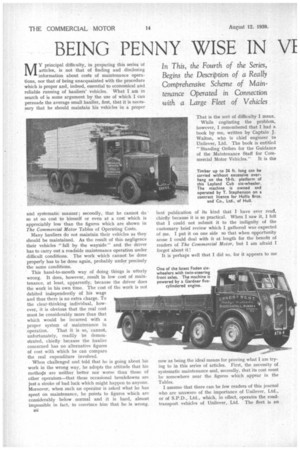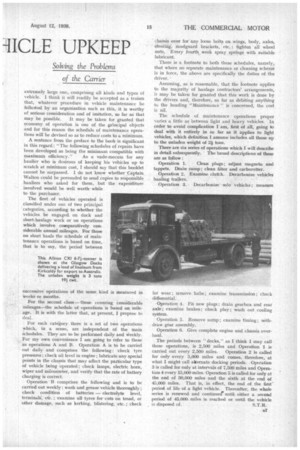BEING PENNY WISE IN VI iICLE UPKEEP
Page 40

Page 41

If you've noticed an error in this article please click here to report it so we can fix it.
in This, the Fourth of the Series, Begins the Description of a Really Comprehensive Scheme of Maintenance Operated in Connection with a Large Fleet of Vehicles MY principal difficulty, in preparing this series of articles, is not that of finding and disclosing information about costs of maintenance operations, nor that of being unacquainted with the procedure which is proper and, indeed, essential to economical and reliable running of hauliers' vehicles. What I am in search of is some argument by the use of which I can persuade the average small haulier, first, that it is necessary that he should maintain his vehicles in a proper
and systematic manner; secondly, that he cannot do so at no cost to himself or even at a cost which is appreciably less than the figures which are shown in The Commercial Motor Tables of Operating Gists.
Many hauliers do not maintain their vehicles as they should be maintained. As the result of this negligence their vehicles "fall by the wayside" and the driver has to carry out a roadside maintenance operation under difficult conditions. The work which cannot be done properly has to be done again, probably under precisely the same conditions.
This hand-to-mouth way of doing things is utterly wrong. It does, however, result in low cost of maintenance, at least, apparently, because the driver does the work in his own time. The cost of the work is not debited independently of his wage and thus there is no extra charge. To the clear-thinking individual, however, it is obvious that the real cost must be considerably more than that which would be incurred with a proper system of maintenance in operation. That it is so, cannot, unfortunately, readily be demonstrated, chiefly because the haulier concerned has no alternative figures of cost with which he can compare the real expenditure involved.
When challenged and told that he is going about his work in the wrong way, he adopts the attitude that his methods are neither better nor worse than those of other operators—that these occasional breakdowns are just a stroke of bad luck which might happen to anyone. Moreover, when such an operator is asked what he has spent on maintenance, he points to figures which are considerably below normal and it is hard, almost impossible in fact, to convince him that he is wrong.
That is the sort of difficulty I mean.
While cogitating the problem, however, I remembered that I had a book by me, written by Captain J. Walton, who is chief engineer to Unilever, Ltd. The book is entitled "Standing Orders for the Guidance of the Maintenance Staff for Commercial Motor Vehicles." It is the
best publication of its kind that I have ever read, chiefly because it is so practical. When I saw it, [felt that I could not submit it to the indignity of the customary brief review which 1 gathered was expected of me. I put it on one side so that when opportunity arose I could deal with it at length for the benefit of readers of The Commercial Motor, but I am afraid I forgot about it :
It is perhaps well that I did so, for it appears to me
now as being the ideal means for proving what I am trying to in this series of articles. First, the necessity of systematic maintenance and, secondly, that its cost must be somewhere near the figures which appear in the Tables.
I assume that there can be few readers of this journal who are unaware of the importance of Unilever, Ltd., or of S.P.D., Ltd., which, in effect, operates the roadtransport vehicles of Unilever, Ltd. The fleet is an extremely large one, comprising all kinds and types of vehicle. I think it will readily be accepted as a truism that, whatever procedure in vehicle maintenance be follorired by an organization such as this, it is worthy of serious consideration and of imitation, so far as that may be possible. It may be taken for granted that economy of operation is one of the principal objects and for this reason the schedule of maintenance opera tions will be devised so as to reduce costs to a minimum.
A sentence from the preface to the book is significant in this regard: "The following schedules of repairs have been developed as being the minimum compatible with maximum efficiency." As a vade-mecum for any haulier who is desirous of keeping his vehicles up to scratch at minimum cost, I should say that this booklet cannot be surpassed. I do not know whether Captain Walton could be persuaded to send copies to responsible hauliers who asked for them, but the expenditure involved would be well worth while to the purchaser.
The fleet of vehicles operated is classified under one of two principal categories, according to whether the vehicles be engaged on dock and short-haulage work or on operations which involve comparatively considerable annual mileages. For the on short hauls the schedule of maintenance operations is based on time, that is to sly, the period between
successive operations of the same kind is measured in weeks or months.
For the Second class—those covering considerable mileages—the schedule of operations is based on mileage. It is with the latter that, at present, 1 propose to deal.
For each category there is a set of two operations which, in a sense, are independent of the main schedules. They are to be performed daily and Weekly. , For my own convenience I am going to refer to these as operations A and B. Operation A is to be carried out daily and comprises the following : check tyre pressures; check oil level in engine ; lubricate any special points in the chassis that may affect the particular type of vehicle being operated ; check lamps, electric horn, wiper and mileometer, and verify that the rate of battery charging is correct.
Operation B comprises the following and is to be carried out weekly: wash and grease vehicle thoroughly ;
check condition of batteries — electrolyte level, terminals', etc' ; examine all tyres for cuts on tread, or other damage, such as kerbing, blistering, etc. ; check chassis over for-any loose bolts on wings, body, axles, steering, mudguard brackets, etc. ; tighten all wheel nuts. Every fourth, week spray springs with suitable lubricant,
There is a footnote to both these schedules, namely, that where no separate maintenance or cleaning scheme is in force, the above are specifically the duties of the driver.
Assuming, as is reasonable, that the footnote applies to the majority of haulage contractors' arrangements, it may be taken for granted that this work is done by the drivers and, therefore, so far as debiting anything to the heading "Maintenance" is concerned, the cost is nil.
The schedule of Maintenance operations proper varies a little as between light and heavy vehicles. In order to avoid complication I am, first of all, going to deal with it entirely in so far as it applies to light vehicles, which definition I assume includes all those up to the unladen weight of 24 tons.
There are six series of operations which I will describe in detail subsequently. The broad descriptions of these are as follow : Operation 1. Clean plugs ; adjust magneto and tappets. Drain sump; clean filter and carburetter.
Operation 2. Examine clufch. Decarbonize vehicles hauling trailers_ Operation 3. Decarbonize solo vehicles ; measure for wear ; remove hubs ; examine transmission: check differential.
Operation 4. Fit new plugs ; drain gearbox and rear axle; examine brakes ; check play ; wash out cooling system.
Operation 5. Remove sump ; examine timing; withdraw gear assembly.
Operation 6. Give complete engine and chassis overhaul.
The periods between "docks," as I think I may call these operations, is 2,500 miles and Operation 1 is carried out every 2,500 miles. Operation 2 is called for only every 5,000 miles and comes, therefore, at what I might call alternate docking periods. Operation 3 is called for only at intervals of 7,500 miles and Operation 4 every 15,000 miles. Operation 5 is called for Only at the end of 30,000 miles and the sixth at the end of 45,000 miles. That is, in effect, the end of the first' period of life of a light vehicle. Thereafter, the whole series is renewed and continuer until either a second period of 45,000 miles is reached or until the vehicle
is disposed of. S.T.R.




















































































